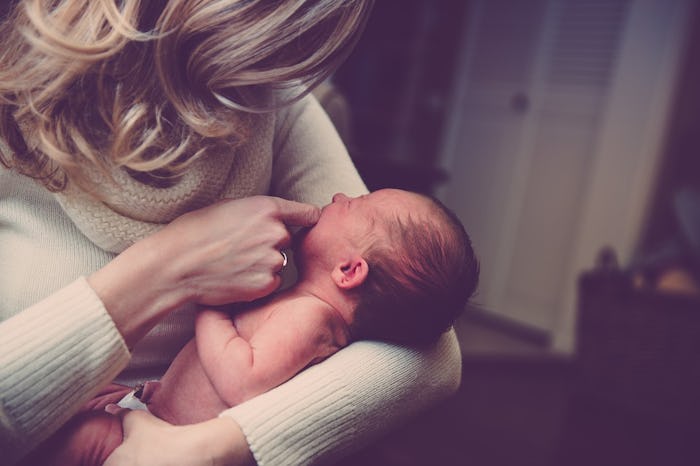There are few things that strike fear into the heart of a parent like sudden infant death syndrome. Learning how to protect your baby from SIDS is a must on every parent's to-do list, but it can still be terrifying to even think about it.
According to the Mayo Clinic, SIDS is the unexplained death of a relatively healthy baby younger than one year old and usually occurs while a baby is sleeping. Although the cause is unknown, it's believed that SIDS may correlate with abnormalities in the brain, affecting an infant's control of breathing and arousal from sleep. But, thanks to a lot of research, scientists have discovered some factors that could put your child at a higher risk of SIDS and how you can help protect them.
Of course, because nobody is really sure why SIDS happens, following these nine ways to protect your baby from SIDS doesn't guarantee a healthy child. But it can give you and your family some peace of mind knowing you are doing the best possible thing for your child. Your intuition is your best weapon against SIDS, but these nine forms of protection are pretty easy to implement and often include creating a safe environment for your baby. You might still creep into their room every night to check on their breathing, but that's OK. You'll be doing that way past the age of one.
1Educate Yourself & Those Caring For Your Baby
It's easy to get yourself worked up over SIDS — it's a tragic reality some parents have faced. But before you get too anxious, know the facts and share them with your child's caregivers. According to the American Academy of Pediatrics, one in five SIDS cases occur when the infant is being cared for someone other than their parent. It's incredibly important to talk to your child's babysitter, even well-meaning family members who insist your child will turn out fine no matter what, so that everyone is on the same page when it comes to protecting your little ones.
2Put Your Baby To Sleep On Their Back
Your parents most likely put you to sleep on your stomach, but in 1994, the Back to Sleep campaign spearheaded by the American Academy of Pediatrics recommended that all babies be put to sleep on their backs to prevent SIDS. It worked — the amount of SIDS deaths from babies being put to sleep in the prone position dropped from 85.4 percent to 30.1 percent . The recommendation is still prevalent and it is becoming more widely known that all babies should be placed to sleep on their backs.
3Keep Their Crib Safe
Although putting a baby to sleep on their back did decrease SIDS-related deaths, the American Academy of Pediatrics noted that researchers found that suffocation and entrapment deaths increased. Your baby's sleep environment could put them at risk of SIDS, especially if they are sleeping with a blanket or bumper pads. The Centers For Disease Control and Prevention recommended using a firm sleep surface, like a crib mattress with a fitted sheet, and making sure there are no loose objects to block your baby's air path like blankets, stuffed animals, or pillows.
4Avoid Keeping Them Too Warm
You want to keep your baby warm, but keeping them too warm definitely doesn't help. Fit Pregnancy noted that researchers believe having a baby too warm can destabilize their breathing pattern and affect their ability to arouse from sleep and breathe. The National Institute of Child Health and Human Development suggested that you should dress your baby in no more than one layer more of clothing an adult would wear to be comfortable. Use breathable fabrics for swaddles and keep pajamas light if you are layering over them, especially when sleeping.
5Keep Your Baby Away From Smokers
Anything that can affect your baby's oxygen is a no-no and that definitely includes cigarettes. According to The National Institute of Child Health and Human Development, babies who share a bed with a smoker or have a caregiver who smokes are at a higher risk of SIDS and babies whose mothers smoked while they were pregnant are up to three to four times more likely to die of SIDS than children whose mothers didn't smoke.
6Room Share
Bed-sharing isn't considered a healthy practice if you want to avoid SIDS, but room sharing is. The American Academy of Pediatrics recommended room sharing with your baby by having them sleep on an entirely different surface than you, such as a bassinet or crib, but keep them in the same room.
7Breastfeed
If you can breastfeed, you can help protect your baby from SIDS. The Mayo Clinic noted that it is best for mothers to breastfeed their babies for at least the first six months to help reduce the risk of SIDS.
8Give Your Baby A Pacifier
Forget everything you've heard about pacifiers — it could save your baby's life. Research conducted in 2012 found that a pacifier could reduce a baby's risk of SIDS, even when baby was in tummy and side sleep positions.
9Vaccinate Your Children
As if you needed another reason to tell the anti-vaxxers why you vaccinate your child, right? According to The National Institute of Child Health and Human Development, keeping your child up to date on their immunizations can reduce their risk of SIDS by 50 percent.
